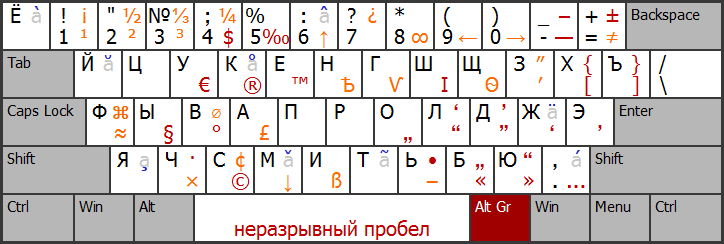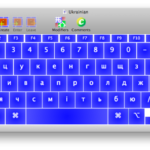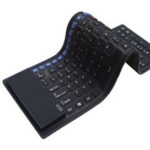Keyboard layout
 Competent use of peripheral devices included in the environment of any computer or laptop is impossible without knowing what the keyboard layout is. A complete understanding of what this category represents will allow the user to significantly expand their professional capabilities.
Competent use of peripheral devices included in the environment of any computer or laptop is impossible without knowing what the keyboard layout is. A complete understanding of what this category represents will allow the user to significantly expand their professional capabilities.
The content of the article
What is a keyboard layout
The layout generally refers to the order in which the icons and symbols of the selected alphabet (Latin or Russian) are arranged in certain positions of the keyboard field. Simply put, if the Russian character set is selected, then in any case, in the middle row, for example, the letters from “f” to “e” will be located. In general, when the OS is running “by default”, the keyboard field will look as shown in the figure below.

If in a particular situation the Latin set of icons is selected, when you press a certain key, English letters or special characters corresponding to this option are typed.
Important! Thus, along with the concept of “layout”, the term “input language” is introduced, indicating which of the language packages stored in the OS is currently selected.
What are the different keyboard layouts?
The Russian typesetting and Latin alphabet described above relate exclusively to the “software” layout, which is such in the generally accepted sense of the word.In addition, several options can be selected for each individual language. For Russian typing, in particular, the usual scheme is introduced - YTSUKEN and its phonetic version (YAVERTY).
There are three modifications for the Latin alphabet, namely:
- typical QWERTY;
- Dvorak diagram;
- Colemak layout.
Please note: The same type is often used for several languages at once.
Thus, the Latin QWERTY, in a particular case, can be used to input and display five foreign languages. Their set in different Windows operating systems may differ significantly.

In addition to the software input method, other types of input are possible that establish correspondence not according to the linguistic principle. According to the accepted classification, they are divided into the following types:
- Mechanical, establishing the shape, size and relative location of the buttons.
- Visual, used to mark individual keys.
- A special “functional” layout entered by group or single click:
- Hardware that establishes the necessary correspondence between icons and symbols.
The last type is permanent for most keyboards.
Why are the letters arranged this way?
The most famous of the layout schemes (English QWERTY) was mostly chosen by chance. In the era of typewriters, incompletely developed typing mechanisms were used, which is why adjacent levers caught and were pressed at the same time. Therefore, the designers decided to place frequently used symbols along the edges of the printed field. True, we had to sacrifice typing speed, but the number of damaged documentation sheets has noticeably decreased.
Additional Information! In addition, letters were spaced out, which in standard combinations (in frequently occurring words) followed one after another. This technique made it possible to increase the speed of typing with two hands.
In addition, it is quite plausible that the QWERTY combination allowed sellers to type the keyword “typewriter” using only the top row. The complete dominance of this layout and its transformation into a standard became possible only in 1888. Since that time, speed typing courses for people with limited vision have become widespread. They decided to use QWERTY.
After this, the network effect mechanism worked, when it was profitable to sell models of machines for which operators who had already mastered this layout were already trained. On the other hand, users tried to purchase exactly those models on which the already mastered scheme was used. Subsequently, it was transferred one to one to the keyboards of the first computers (the ancestors of modern computers).
Keyboard layouts
One of the well-known layout schemes takes into account languages related to Russian (Ukrainian alphabet and Belarusian). Her large appearance with characteristic icons is given below.

Ukrainian and Belarusian
In this diagram, the main differences are marked in green in comparison with the Belarusian one, and in blue – with the expanded Ukrainian one. The “AltGr” key is only possible in the Ukrainian version; it is used to enter the letter “Ґ”, marked in red.
Note! The latter layout scheme is only possible on OS versions starting from Windows Vista and subsequent ones.
Capital letters “b” and “s” can be typed here, but only when “Caps Lock” is turned on. The capital letter “Ѝ” is also present in this scheme (a separate key is used to enter it). In its absence, this icon is typed in the same way as “Y” (that is, “Caps Lock” while pressing “Shift”).
Another diagram is represented by the so-called “typographical” layout of Ilya Birman (a close-up of the layout is located in the picture below).

It offers the best way to type different types of typographic quotation marks.
Latin
Among the schemes of this class, the main ones are the standard American and French layouts (the first is shown in the figure below in the text). The Android phone has the same layout.

To write some French letters, the symbol “~” and “`” can be entered by pressing the so-called “dead key”, and immediately after that – the space bar, or rather:
“Alt Gr”+“é”, “space” →“~” and “Alt Gr”+“е”, “space” →“`”.
How to add and switch languages
To switch the language scheme of any keyboard (as well as to add a new language), each version of Windows has its own service. You can access it in XP, for example, in the standard way - through the “Control Panel”, in which you should find the “Language and Regional Standards” column. After this, you need to select the “Languages” tab and find “More details” in the window that opens.
Following this, a new window will appear in which you need to designate the main keyboard layout (Russian, for example).
Additional Information! The previously primary English language will need to be removed.

Next, you will need to click “Add” and select an additional layout (in this case, English).
To switch the language during work, click on the “Language Panel” tab, after which its form will appear in the tray around the clock. After this, all that remains is to check the box next to the desired position (Rus/Eng). The same result can be achieved if you press the Alt+Shift key combination.
In Windows 7, you will have to do the following to do this:
- Call the context menu on the language bar and select “Options” from the list that appears.
- After selecting them, the Languages and Text Input Services dialog box will appear.
- In it you should go to the “General” tab, in which deleting and adding languages is carried out similarly to the case already discussed earlier.
- To select a method for switching from one layout to another, you need to select the tab called “Keyboard Switching”.
In the dialog box that opens, you will be offered an intuitive way to change the language (if you click on “Change keyboard shortcuts”). After this, you can do this by pressing the combination of buttons that were selected in the previous action.





